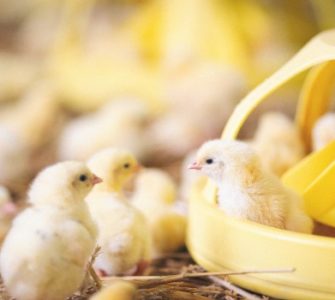Caution: Simple errors can derail IBV vaccine effectiveness
Common pitfalls that can occur while vaccinating broilers against infectious bronchitis virus (IBV) could derail vaccine effectiveness, panelists cautioned during an industry roundtable, “Infectious Bronchitis: Evolving Strategies for an Evolving Virus.”
“You’re in a broiler hatchery with a lot of moving parts, so you need to pay attention to details,” said Kalen Cookson, DVM, director of clinical research, Zoetis.
IBV viruses are fragile, so it’s critical to keep vaccine titers as high as possible, especially when IBV vaccines are applied by spray. “This is why using full doses is important — to preserve as much of the titer as we can before the bird actually sees it and responds,” he said.
Cool water
Cookson noted that preparation with frozen bronchitis products differs somewhat from preparation of a Marek’s vaccine, “and the people who are preparing the bronchitis vaccine may be the same people preparing the Marek’s vaccine.”
Frozen bronchitis vaccines should not be allowed to thaw completely, and cool water should be used to mix with the vaccines. “The cooler the water you can mix it with, the better. It should be 60° F (16° C) or lower, at least when you’re mixing, and even at application…
“When you get up above 70° F to 80° F (21° C to 26° C), the titer can really start coming down quickly,” he cautioned.
Mark Jackwood, PhD, a molecular virologist at the University of Georgia who has worked extensively with the virus, heartily agreed based on his experience studying spray vaccination with an IBV vaccine.
“If we mixed the vaccine with water that was 39° F (4° C ) and we kept it at that temperature, we maintained the titer for well over 120 minutes. If you mix it with room-temperature water and let it sit at room temperature, you lose almost a log immediately. There’s literally no vaccine there after about 120 minutes.”
It’s also important to maintain syringe-based spray cabinets because if they aren’t kept in perfect working order, mechanical shearing forces can damage a lot of the virus.
“We have to make sure those syringes are working properly,” Jackwood insisted. “They are disposable syringes. And that means you’re supposed to dispose of them, right? But some people use them for days on end.”
Jackwood also said preventing air in the lines was also critical. If there’s air and the syringes aren’t completely full of vaccine, a full dose isn’t being given. Clogged nozzles are another big issue. “I’ve seen where they’ve got two nozzles and one of them is not spraying anything,” he said.
Check air pressure
Guillermo Zavala, DVM, PhD, founder of Avian Health International and an adjunct professor, University of Georgia, said the most common problem he sees is a failure to check air pressure. If the spray cabinet calls for a 50 psi and 78 psi is used, that along with the shear force applied with a syringe system essentially destroys the virus.
Having good-quality storage equipment is also essential. As Mark Burleson, DVM, Wayne Farms, put it: “Let’s not forget about storage. We don’t want to put thousands of dollars’ worth of vaccine into a $200 refrigerator we got on clearance at a home store because it’s dented.”
He and Zavala said vaccines should be stored within the refrigerator, not on refrigerator-door shelves. Burleson said his company has alarms on all the refrigerators so vaccines don’t freeze or get too warm.
Jackwood said that hatcheries typically give 7-ml volumes. “ I don’t know where 7 ml came from, but we found if you increase that to a 14-ml volume, you get more vaccine into the chicks. If you increase it to 21 ml, you get a lot of vaccine to the chicks.”
Between keeping IBV vaccines cold and giving 14 ml or 21 ml to chicks in winter, there are sometimes concerns about fragile chicks becoming chilled. Jackwood didn’t think that was an issue, however, noting that “our experience is that if the hatchery is managed properly and it’s warm, the chicks will dry out in less than 30 seconds and they’ll be just fine.”
Water sanitation also must be considered when administering IBV vaccines in water, said Meagan Slater, DVM, Mountaire Farms. Water lines need to be primed and drained. “Do you use a dye? Are you making sure the birds’ uptake of vaccine occurs in the appropriate amount of time? There’s definitely a checklist you go through” to ensure birds are properly vaccinated.
Crew size matters
Field boosting also presents challenges, noted David French, DVM, formerly with Sanderson Farms and now a professor at the University of Georgia. One common mistake is not having enough people to spray vaccinate.
“The best vaccinators we have know exactly how many steps it is from one end of the house to the other. They know exactly how much time it’s going to take them to vaccinate, and they finish vaccination with no vaccine left over. They don’t run out before they’re done. Those things all have to happen in order to spray vaccine properly. It’s when we take shortcuts that we get in trouble.”
Sarah Tilley, DVM, Fieldale Farms, said it’s important for the number of people vaccinating to be proportionate to the size of the house. In a 40-foot-wide house, for example, there will be two people with backpack sprayers and for a 50-foot or wider house, there will be three.
Real-time polymerase chain reaction testing can be valuable for checking the effectiveness of vaccine application, said the University of Georgia’s Jackwood.
“We can monitor 5 or 10 days after vaccine application to see what percent of birds in that flock actually received vaccine and how much.
“It’s not cheap,” he added. “Maybe you’re not going to do it with every single house, but if you spot check your crews every once in a while, you can be fairly sure you’re doing a good job,” he said.
Editor’s note: This report was adapted from “Infectious Bronchitis: Evolving Strategies for an Evolving Virus,” highlights of a roundtable discussion sponsored by Zoetis. To download a free copy, click here.
Posted on April 27, 2020

















